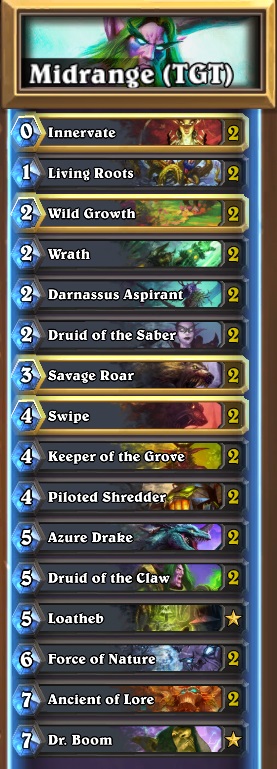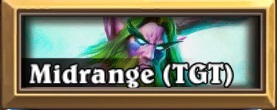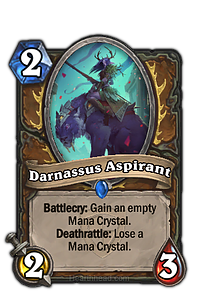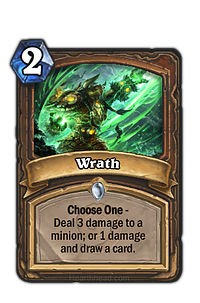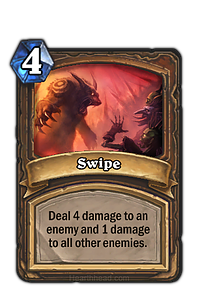Midrange (TGT)
In the first few weeks after a new set of cards are added, most people have success by tweaking existing deck types and making them stronger with a few new cards. This is exactly the strategy behind our Deck of the Week, midrange druid.
Midrange druids have been around for a long time, but had fallen out of favor recently because the Warrior/Hunter/Warlock triad was just too strong after Blackrock Mountain. The cards that the druid class got from that adventure were less than ideal in most cases, or simply outstanding in only niche cases. The Grand Tournament has been much better to the druid class, adding several new early game cards that help the class compete until it can overwhelm you or burst you down.
This version comes from Odinn over at http://www.icy-veins.com/, who used this deck to reach legendary rank in the August season. I’ve been using it myself this past week and had quite a bit of success with it.
The Basics
Midrange druid likes to get board control early on and keep it until they can reach turn 9+ to use the Force of Nature + Savage Roar combo to finish off their opponent. Where it really struggled was gaining solid footing in the early game. Previously, without Wild Growth to ramp up to an early 4 mana drop, or Innervate to again drop a big threat earlier than usual, it was very easy for midrange druids to fall behind on board and not be able to keep up long enough to unleash their finishing combo. Well, The Grand Tournament has changed that.
This deck features three of the cards introduced in TGT that significantly improve the druid’s early game. The star of the show is of course the Darnassus Aspirant. Not only is she a sturdy 2 mana minion, but she also helps to ramp up your mana crystals. A turn 2 Wild Growth is a powerful play in it’s own right, letting you skip ahead to 4 mana crystals. Darnassus Aspirant, then, is insanely powerful, letting you skip ahead to 4 mana crystals and putting down a 2/3 body.
To balance the card out, you do lose the mana crystal when Darnassus Aspirant dies. This however is also in your favor. Because the Aspirant is such a big threat, most opponents will have to use a removal spell to get rid of it the turn that it’s played. If they can’t, you can still use your free mana crystal to play a bigger minion, and afterwards trade into your opponent’s minion. That way, you still get full value from the extra mana and maintain board control as well.
More Early Game
The next important early game card that was added with TGT is Living Roots. This handy little spell gives you a choice: deal 2 damage to an enemy, minion or hero, or summon 2 1/1 treants. Because this spell only costs 1 mana, it is an excellent tempo play against aggressive decks. Play this on turn 1, and you’ll have a way to deal with either 2 1-health minions or 1 2-health minion on your next turn. That can help clear the way for your Darnassus Aspirant to get full value.
Rounding out the new cards is the Druid of the Saber. This new druid is similar to the bigger Druid of the Claw. You can play the card in charge mode for no extra stats, or you can play it in stealth mode and gain a +1/+1 stat boost. While I’m sure the stealth mode is better value, I often find myself playing the Saber in charge mode, either to clear an early threat or to help me finish off something that my spells can’t handle.
The Midgame
While midrange druid’s early game is significantly improved, the midgame is still where this deck shines. Using powerful spells like Swipe and Wrath to keep board control, around turn 5 is when you start putting down your big threats. Druid of the Claw is a very flexible 5 mana minion. A 4/6 with taunt is very daunting on turn 5, while a 4/4 with charge can often get two trades before going down or kill a high priority target.
Another excellent midgame card is the Ancient of Lore. This summons you a 5/5 body with the option of drawing two cards or healing something for 5 health. Most often you will want to draw cards, but, against extremely aggressive decks, an extra 5 health when they are topdecking to finish you off can often seal the game for you. This deck also runs the fairly standard Loatheb and Dr. Boom as well, giving you lots of power going into your later turns.
The ultimate goal of this deck hasn’t changed though. You will usually win by some combination of Savage Roar and Force of Nature. While you don’t want to keep these cards in your starting hand, it’s very tough to finish off a game without drawing at least one of them. Once you get close to turn 9 or have two or more minions on the board, start counting possible damage, looking to kill your opponent. Savage Roar math can be tricky first, but with practice, counting up all the possible damage in your hand will become second nature. Always be looking for the chance to finish off your opponent, even if the right combination isn’t apparent at first.
I’m excited to see what possibilities are on the horizon thanks to the TGT card set. This druid list is very solid and has good match-ups in most cases. If you have an awesome new deck that is working well for you, let me know in the comments or on Twitter @AGRitterific.
